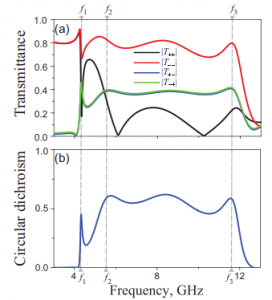 In a paper entitled “3D-Printed Chiral Metasurface as Dichroic Dual-Band Polarization Converter,” a team of researchers discusses designing a 3D chiral metasurface behaving as a spatial polarization converter with asymmetric transmission.
In a paper entitled “3D-Printed Chiral Metasurface as Dichroic Dual-Band Polarization Converter,” a team of researchers discusses designing a 3D chiral metasurface behaving as a spatial polarization converter with asymmetric transmission.
“The metasurface is made of a lattice of metallic sesquialteral (one and a half pitch) helical particles,” the researchers explain. “Each particle contains six rectangular bars arranged in a series one above the another creating a spiral. The proposed metasurface exhibits a dual-band asymmetric transmission accompanied by the effect of a complete polarization conversion in the response on the particular distributions of currents induced in the particle’s bars by an incident wave. Regarding circularly polarized waves the metasurface demonstrates a strong circular dichroism.”
An optical diode, the researchers continue, is a device transmitting light in one direction and blocking it in the reverse direction. Among various types of optical diodes, one well-known example of this non-reciprocal response is “the magnetooptical (Faraday) effect related to circularly polarized light propagating in gyrotropic materials.”
“The biased magnetic field breaks the time-reversal symmetry, which leads to a nonreciprocal response of media,” the researchers state. “This mechanism is accompanied by the effect of circular dichroism related to differential absorption of the left-handed and right-handed circularly polarized waves. However, the nonreciprocal response is not restricted to the use of magnetic field only. Indeed, optical diodes can be constructed by utilizing spatial-temporal modulations of refractive indices or some nonlinear effects for which the reciprocity theorem is violated.”
Alternatively, they add, an asymmetric transmission can be realized in chiral artificial structures, or metamaterials, even when they are completely reciprocal. There are limitations to chiral metamaterials based on 2D planar technologies, however. The first limitation is related to their electromagnetic properties, considering that a complete asymmetric transmission is a resonant feature strongly dependent on dissipation. The second limitation is that commercial glass epoxy laminates cannot provide mechanical support of metallic patterns at extremely high temperatures, which restricts their application area.
 The researchers discuss the design of a 3D chiral metastructure using 3D printing from a metallic alloy, namely cobalt chromium. Because the alloy has a high melting temperature, it can prevent the metasurface structure from being destroyed in an extreme working environment. This is a unique advantage of the alloy-based metasurface compared to the chiral components patterned on glass epoxy laminates. The researchers demonstrated a dual-band asymmetric transmission feature as well as a strong broadband circular dichroism in the proposed metasurface, both theoretically and experimentally.
The researchers discuss the design of a 3D chiral metastructure using 3D printing from a metallic alloy, namely cobalt chromium. Because the alloy has a high melting temperature, it can prevent the metasurface structure from being destroyed in an extreme working environment. This is a unique advantage of the alloy-based metasurface compared to the chiral components patterned on glass epoxy laminates. The researchers demonstrated a dual-band asymmetric transmission feature as well as a strong broadband circular dichroism in the proposed metasurface, both theoretically and experimentally.
“We argue that a complete polarization conversion can be reached by solving a geometrical optimization problem for the required frequency band,” the researchers conclude. “In such a way, our work paves the way to find an industrially high-temperature component solution on polarization conversion an separating communication channels utilizing features of the linear asymmetric transmission and strong circular dichroism at microwaves as well as at higher frequencies.”
Authors of the paper include Shengzhe Wu, Su Xu, Tatiana L. Zinenko, Vladimir V. Yachin, Sergey L. Prosvirnin and Vladimir R. Tuz.
Discuss this and other 3D printing topics at 3DPrintBoard.com or share your thoughts below.
Subscribe to Our Email Newsletter
Stay up-to-date on all the latest news from the 3D printing industry and receive information and offers from third party vendors.
You May Also Like
Printing Money Episode 17: Recent 3D Printing Deals, with Alex Kingsbury
Printing Money is back with Episode 17! Our host, NewCap Partners‘ Danny Piper, is joined by Alex Kingsbury for this episode, so you can prepare yourself for smart coverage laced...
Insights from Cantor Fitzgerald on AM’s Q1 2024 Landscape
A recent survey by Cantor Fitzgerald sheds light on the persistent challenges within the additive manufacturing (AM) industry in the first quarter of 2024. Based on responses from 38 industry...
3D Printing Financials: Xometry’s Scaling up and Strong Start to 2024
Xometry (Nasdaq: XMTR) kicked off 2024 with strong results, boosting its marketplace and technology to new heights. Both revenue and gross margin soared, fueled by an expanding global network of...
3D Printing Financials: Desktop Metal Targets Recovery Amid Net Losses and Revenue Downturn
Despite facing a decline in revenue and the persistent challenges of a tight economic climate, Desktop Metal (NYSE: DM) is making strides toward operational efficiency. The first quarter of 2024...

































